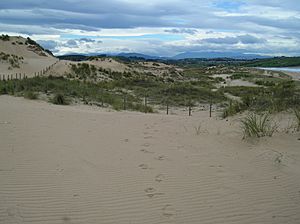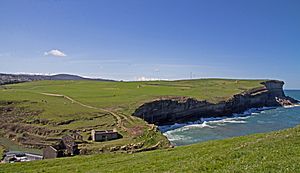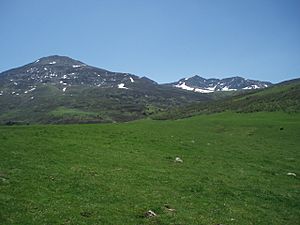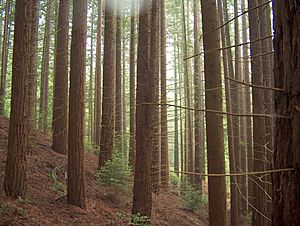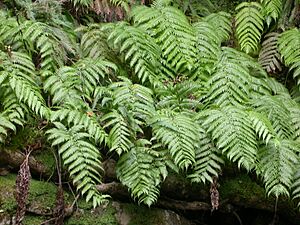Flora of Cantabria facts for kids
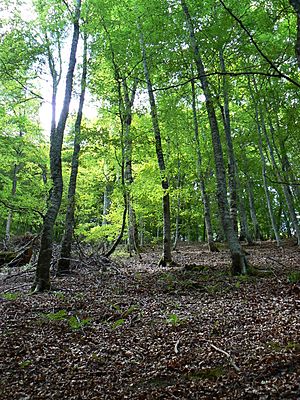
The flora of Cantabria means all the plants that grow naturally in this region of Spain. The types of plants you find here depend on three main things: the climate (weather), the soil (what kind of dirt it is), and the long history of how plant groups have changed over time.
Cantabria is special because it sits between two big plant regions. Most of it is part of the Eurosiberian region, which has lots of green forests. But the very south of Cantabria is part of the Mediterranean region, which has plants that like warmer, drier weather. This mix means you can find both Mediterranean and Atlantic plants here, making Cantabria's plant life super rich and interesting!
Contents
How Cantabria's Plants Came to Be
Cantabria's plants grow on two main types of ground. Some areas, like Peña Cabarga or Picos de Europa, have lots of limestone rocks. Here, the soil is thin, and many rocks stick out. Plants that grow here are special and can handle these rocky, lime-rich soils. This type of plant life is common in the eastern part of Cantabria.
Other areas have "acidic" rocks like sandstones or clays. These rocks don't give the soil many nutrients. Plants that like this kind of soil are found in the high parts of the Cantabrian Mountains.
The history of how plants have changed over thousands of years also shapes what we see today. The Ice Ages and warmer periods in between caused big changes. Sometimes, the land was like a cold tundra with small plants. Other times, warm forests with trees that lose their leaves (deciduous) spread everywhere.
About 3,000 years ago, the plants in Cantabria started looking similar to how they do now. Big forests of deciduous trees, mixed with some Mediterranean evergreen trees, covered the land from the sea up to about 1,700-1,900 meters high. Today, only a small part of these original forests remains, usually in hard-to-reach places. In most other areas, people have changed the forests. They've been replaced by heaths, scrublands, and pastures for farm animals.
To understand Cantabria's plants, we can look at different "climate zones" based on how high up they are. Cantabria has four main zones: the hilly zone, the montane zone, the subalpine zone, and the alpine zone. The alpine zone is only found on the highest peaks of the Picos de Europa.
Hilly Zone
The hilly zone is found from sea level up to about 500-600 meters high. In this area, you mostly see green fields used for dairy cows. People created these fields by clearing the old forests that used to cover the land. This zone has been changed the most by human activity, as it's where most people live and where many roads and farms are. So, its natural areas are quite altered.
In this coastal area, you'll find plants typical of:
- Beaches and dunes
- Cliffs
- Marshes
- Hay meadows
- Mixed deciduous forests
- Holm oak groves
- Riverside forests
- Eucalyptus plantations
Dunes
Coastal dunes are very special and endangered places in Cantabria. The plants that grow here are unique to dunes. If these dunes disappear, we would lose these specialized plants forever.
Close to the sea, where sand is dropped by the tide, you'll find the first plants that start to grow on the dunes. These include the northern couch grass (Elymus farctus), often with prickly saltwort (Salsola kali), searockets (Cakile maritima), and arenaria (Honkenya peploides).
Further inland, the sand dunes get taller. Here, plants help to hold the sand in place. The most important plant for this is the beachgrass (Ammophila arenaria). Its wide spread and tangled roots make it great at stopping the sand from moving. Other plants here are the sea holly (Eryngium maritimun), carex (Carex arenaria), and sea spurge (Euphorbia paralias).
Even further inland, in more sheltered parts of the beach, the sand is stable. Here, you'll find meadows with plants like Festuca rubra, Lolium perenne, Lagurus ovatus, and Briza maxima. You might also see Medicago marina, M. littoralis, Linaria maritima, Dianthus monspessulanus, and Otanthus maritimus.
Cantabria has the biggest dune field on the Cantabrian Sea, called the Liencres Dunes. It's a natural park because of its large dunes and how well it's been kept. However, new buildings nearby threaten this special place.
Coastal Flora
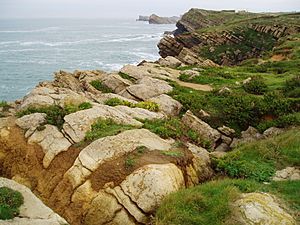
The steep cliffs along Cantabria's coast are home to plants that can live close to the sea. These plants grow on two types of rock: hard limestone and softer marl and sandstones.
The first plants closest to the sea grow in cracks in the rocks. These include sea fennel (Crithmum maritimum) and sea plantain (Plantago maritima). In more sheltered cracks, you might find spleenworts (Asplenium marinum).
As you move away from the sea, the plants become more plentiful. You'll see armenia maritima (Armenia maritima and A. pubigera ssp. depillata) and sea lavender (Limonium lanceolatum). Areas where plants can't grow are covered by lichens, like Xantoria parietina.
Where there's more soil, new plants appear, such as the wild carrot (Daucus carota ssp. gummifer), Portuguese angelica (Angelica pachycarpa), or sweet alyssum (Lobularia maritima). Small meadows of red fescue (Festuca rubra) also grow here.
Finally, in higher areas far from the sea, you'll find thick bushes of Cornish heath (Erica vagans), genista (Genista occidentalis), and gorse (Ulex europaeus).
Estuaries and Marshes
Marshes are super important habitats in Cantabria because they have the most different types of plants and animals. In Cantabria, you can find well-developed marsh areas in the Santoña, Victoria and Joyel Marshes Natural Park and the Rabia estuary. Like the dunes, these marshes are threatened by building projects nearby.
The plants in marshes are spread out in different ways, mainly depending on how salty the water is.
In the parts of Cantabria's marshes that are most flooded by sea water, you'll find meadows of Zostera marina and Zostera noltii. These plants are actually in danger of disappearing along the European Atlantic coast. Closer to the low tide line, cordgrass (Spartina spp.) grows, followed by salicornia (Salicornia spp.) or limonium (Limonium vulgare). In areas further from the sea, where there's less salt water, you'll see rushes and reed beds like Juncus spp., common reed (Phragmites australis), and Scirpus spp..
Hay Meadows
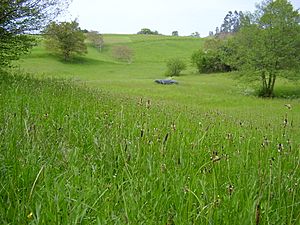
Away from the coast, the landscape is mostly covered by hay meadows. These are fields managed by people to grow food for animals. You'll find grasses like Lolium perenne, Holcus lanatus, and Anthoxanthum odoratum, mixed with plants like clovers (Trifolium pratense, Trifolium repens). These meadows cover the largest area in Cantabria. They are often wide open spaces with few trees or hedges separating them.
Mixed Deciduous Forests
In valleys and hard-to-reach, steep areas, you can still find small parts of the original forests of this hilly zone. These are mixed forests with many different kinds of trees that lose their leaves. The common oak (Quercus robur) is usually the main tree, along with ash (Fraxinus excelsior), maple (Acer pseudoplatanus), birch (Betula celtiberica), linden (Tilia spp.), and chestnut (Castanea sativa).
There are also many tall bushes like the common hazel (Corylus avellana), alder buckthorn (Rhamnus frangula), dogwood (Cornus sanguinea), or laurel (Laurus nobilis). You'll also see climbing plants and plants that grow on other plants, bushes, and smaller plants on the ground. These forests used to grow on the best soils, so they were often cleared for farming. Restoring them is very important.
Holm Oak Forests
In the hilly zone, on rocky limestone ground, you'll find a very interesting plant group called the Cantabrian holm oak forest. This forest has Mediterranean plants, mainly the holm oak (Quercus ilex). It also includes laurel (Laurus nobilis), strawberry tree (Arbutus unedo), and buckthorns (Rhamnus alaternus). All these trees are evergreen (they keep their leaves all year). They mix with Atlantic plants like hazel (Corylus avellana) or hawthorn (Crataegus monogyna).
These holm oak forests need somewhat dry ground, so they grow well on limestone rocks because water drains through them easily. The best holm oak forests are in the Asón valley and Aras valley. Near the coast, the holm oak forest of Monte Buciero in Santoña is very special. It's the most important holm oak forest in northern Spain because of its size and location near the cliffs.
In valleys like Liébana, which have drier summers and more Mediterranean weather, you'll find a different kind of holm oak (Quercus ilex ssp. rotundifolia). This type likes low rainfall and doesn't depend as much on limestone rocks. You can also find kermes oak groves in Valderredible and especially in Liébana. The four valleys of Liébana have kermes oak groves that become the main plants where the valleys meet in Potes.
Riverside Forests
Riverside forests in Cantabria are mostly made up of alder trees (Alnus glutinosa). These alder groves are the main riverside forests in lower areas. In higher areas where alders can't grow, other forest types are found along rivers.
Alder groves have many trees and bushes, plus a rich layer of smaller plants on the ground. Besides alder, you'll often see elm (Ulmus glabra) and ash (Fraxinus excelsior). Other common trees are willows (Salix spp.). Sometimes, you might even find beeches and oaks.
The bush layer has small willows (Salix spp.), like S. atrocinerea, S. cantabrica, and S. purpurea. Other common bushes are dogwood (Cornus sanguinea) or spindle (Euonymus europaeus). These, along with various brambles (Rubus sp.) and climbing plants like Hedera helix and Rubia peregrina, make these forests unique.
On the ground, plants like Carex remota, C. pendula, or Bromus ramosus are common. You'll also find widespread plants like nettle (Urtica dioica), which thrive on the rich soil left by floods.
In Cantabria, alder groves are found in the middle and lower parts of rivers that flow into the Cantabrian Sea and the Ebro river. However, the Camesa river, which flows into the Duero basin, doesn't have these forests, probably because of the high altitude of its course. When valleys are very steep, riverside forests shrink or disappear, replaced by mixed oak groves. This happens in the middle part of the Miera and Nansa rivers.
Another plant group along riverbanks is the willows or shrubby salcedas. These are pioneer plants that grow as a barrier between the river and the alder groves. They also grow back if an alder grove is destroyed. In mountain areas above 1,000 meters where alders don't grow, willows become the main plants along riverbanks. Different types of Salix species grow here depending on the conditions.
Eucalyptus
In the low areas of Cantabria, between sea level and 300 meters high, many native plants have been removed to plant eucalyptus trees. These large areas of the Australian tree Eucalyptus globulus are grown for making paper pulp. Cantabria has some of the largest eucalyptus plantations in Europe. Often, these trees were planted after destroying Cantabria's natural forests. These plantations are like industrial farms and are not true forests. They can harm the soil and water and reduce the number of different plants and animals in an area.
Montane Level
The montane level in Cantabria is generally found between 500 and 1,600 meters high. Here, plants that like warmer weather disappear because of frost. The forests are more uniform and have fewer different types of plants.
The plant life in the montane zone looks very different from the hilly zone. It's a rougher area where hay meadows are much smaller. Instead, bushes and scrublands become common. These are what's left of the old forests that used to cover the slopes. These forests now exist as small, separate patches, usually at the tops of valleys or on steep slopes that are hard for people to reach. They are found near rocks and high pastures, at the upper edge of the montane zone.
The plant groups in this zone include:
- Different types of oak forests
- Beech forests
- Birch forests
- Cork oak forests
- Heath forests (which grow after other communities are damaged)
Oak Forests of Quercus robur
The oak grove of Quercus robur (the common oak) grows in Cantabria up to 1,000 meters high. In these forests, you'll also find ash trees (Fraxinus excelsior), lime trees (Tilia spp.), or chestnut trees (Castanea sativa). Many bushes grow here too, such as holly (Ilex aquifolium), blackthorn (Prunus spinosa), or hazel (Corylus avellana). On the forest floor, various ferns (Dryopteris spp., Polystichum setiferum) and many smaller plants like hellebore (Helleborus viridis) or dog's mercury (Mercurialis perennis) are common.
These oak forests have greatly shrunk because they were used for shipbuilding in the 16th and 17th centuries, and for fuel in factories. Their small, scattered presence now might threaten their survival. The last remaining oak forests in Cantabria are in the mountains between the Saja and Besaya valleys.
Sessile Oak Forests (Quercus petraea)
The sessile oak grove (Quercus petraea) takes over from other oaks at higher elevations, in more inland areas away from the sea. These forests can grow up to about 1,700 meters high, especially on sunny slopes. Along with the sessile oak, you'll find beech (Fagus sylvatica) and rowan (Sorbus aucuparia). The bush layer here is mainly made of heather (Erica arborea) and broom (Cytisus cantabricus), mixed with holly (Ilex aquifolium) and hazel (Corylus avellana). The ground plants are similar to those in common oak groves, but you might also see wood sorrel (Oxalis acetosella) or martagon (Lilium martagon).
These forests are found in the interior valleys of southern and western Cantabria, from Liébana and Polaciones to Campoo. The best example is on Mount Hijedo in Valderredible.
Pyrenean Oak Forests (Quercus pyrenaica)
The Pyrenean oak groves (Quercus pyrenaica) are common on the northern slopes of the Cantabrian Mountains. They especially grow in drier valley areas where beech or other oak groves can't thrive due to needing more water. These forests are found from 700 to 1,400 meters high. Other trees here include ash (Fraxinus excelsior) or maple (Acer campestre). The bush layer is mostly blackthorn (Prunus spinosa), holly (Ilex aquifolium), and broom (Cytisus cantabricus). On the ground, plants like Melampyrum pratense are common.
While small groups of this forest appear throughout the region, the best examples are on the slopes of Peña Sagra.
Portuguese Oak Forests (Quercus faginea)
The oak groves of gall oak or Portuguese oaks (Quercus faginea) are typical of Mediterranean areas and are very rare in the Cantabrian Mountains. In Cantabria, you'll only find a few isolated forests in special spots with specific weather conditions, like in Liébana or Campoo-Los Valles. They always grow on limestone ground on steep, sunny slopes, between 700 and 1,000 meters high. The bush layer in these forests is very diverse, with plants that like dry conditions. The ground layer is also very interesting, with some plants that are very rare in Cantabria.
The best example of this forest type in Cantabria is on La Robleda mountain, in Villacantid (Hermandad de Campoo de Suso). Others are found around Arcera (Valdeprado del Río). In Liébana, only small scattered groups remain.
Beech Forests
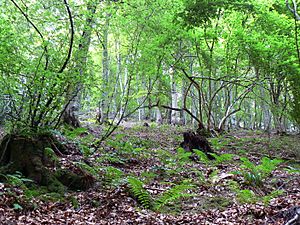
Beech groves (Fagus sylvatica) are the best-preserved forest type in Cantabria. They grow best between 800 and 1,600 meters high, in areas with frequent fog and lots of rain. Cantabria has three kinds of beech forests, depending on the soil they grow on.
First, there are beech forests that grow on acidic soils. These are dense forests almost entirely made of beech trees. On the ground, you'll find plants that like acidic soil, such as Deschampia flexuosa, blueberry (Vaccinium myrtillus), and Luzula sylvatica subs. henriquesii.
Second, there are beech forests that grow in wet areas but on limestone soils. These are very common in the large limestone mountains in eastern Cantabria.
Finally, the rarest beech forests are on limestone soils but on steep, sunnier slopes. These are found at the edges of where beech trees can grow, in the south of the region.
Beech groves are forests where the main tree species leaves little room for other trees and usually has no bush layer. The ground layer is simple and not very developed because little sunlight reaches it. Important plants here include the wild garlic (Allium ursinum) or the orchid Neottia nidos-avis.
The largest beech forests in Cantabria are in Campoo, at the sources of the Nansa and Saja rivers, and especially in Liébana. However, smaller, isolated beech forests are found throughout the region, at the sources of the Besaya, Pas, Miera, or Asón rivers.
Birch Forests
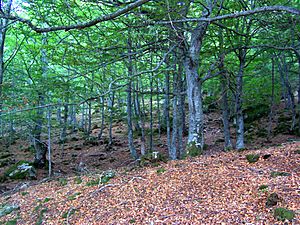
Birch forests grow between 1,600 and 2,000 meters high in western Cantabria, above where other deciduous forests can grow. Birch trees (Betula celtiberica) grow in very poor, acidic soils in areas with lots of rain. A few other trees, like rowan (Sorbus aucuparia) and some isolated beech (Fagus sylvatica) trees, might be found with the birch. The undergrowth has plants typical of the high Cantabrian mountains, such as heather (Erica arborea, Calluna vulgaris), broom (Genista spp.), or blueberry (Vaccinium myrtillus). The ground layer is dominated by plants that like rocky soils, like Avenella flexuosa.
The best-preserved birch groves in Cantabria are at the sources of the Deva, Nansa, Saja, and Híjar rivers. The Ajotu birch grove at the source of the Tanea river is especially notable.
Cork Oak Forests
The very few cork oak groves in Cantabria are all in Liébana. They grow on rocky soils, halfway between the montane and hilly areas. The cork oak (Quercus suber) is a typical Mediterranean tree that doesn't like very cold or dry climates. It appears in Cantabria as a relict, meaning it's a leftover from a time when it was more widespread. It's joined by many bushes like strawberry trees (Arbutus unedo), buckthorns (Rhamnus alaternus), sloes (Prunus spinosa), or hawthorns (Crataegus monogyna), as well as some brooms (Cytisus cantabricus, Genista spp.).
The best cork oak groves are in Tolibes and Valmayor, in Valmeo (Vega de Liébana), and the one that stretches from Frama to Cahecho (Cabezón de Liébana).
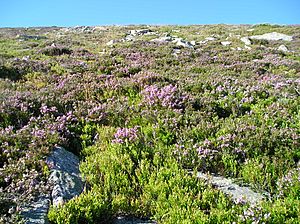
Heath Forests
Heathlands are very common in the montane areas of Cantabria. They grow when deciduous forests are removed, often by wildfires, to create pastures for animals.
These areas, usually dominated by different types of heather, have many different kinds of plants. They include many endemic flora (plants found only in this area), such as Erica mackaiana, Daboecia cantabrica, Calluna vulgaris, or Genista obtusirramea. They are considered important habitats by the Habitat Directive of the European Union.
Subalpine and Alpine Levels
The next high-altitude zone, the subalpine level, is found in Cantabria from about 1,600-1,700 meters high. These heights can change a bit. This zone is fully present on the peaks of the Picos de Europa and in western Cantabria, and also, though smaller, in Castro Valnera. The main plant groups here are grasslands, different types of high mountain scrub, and bogland.
Grasslands
The high mountain pastures, called brañas, are the natural plant cover in Cantabria's highest areas. They are adapted to very long periods of snow. The types of plants here depend a lot on the ground. They cover the natural passes between the large rock masses at the highest points of the region. They are usually found with thick bushes typical of the Cantabrian mountains (heather, gorse, and broom).
There are different kinds of grasslands, with many endemic species (plants found only here), such as Helianthemum urrielense and Festuca burnatii.
These high-altitude pastures provide food for cattle in the mountain passes during the summer, like in Sejos and Áliva passes.
High Mountain Scrub
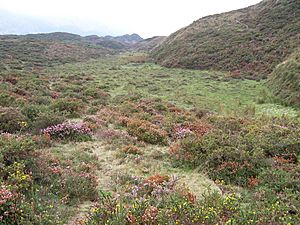
In the limestone mountains, which at these heights are mostly the Picos de Europa, you'll find juniper groves. These are dominated by the common juniper (Juniperus communis subsp. alpina). Other plants like the bearberry (Arctostaphylos uva-ursi) or the spurge-laurel (Daphne laureola) also grow here, hiding in cracks and rocky areas that are covered by snow for only a short time. Plants that like acidic soil, such as blueberries (Vaccinium myrtilus, Vaccinium uliginosum) or heather (Calluna vulgaris), also appear in rocky areas. In these subalpine landscapes, there are many gorse bushes, mainly the Spanish gorse (Genista occidentalis), along with another interesting plant found only in the Cantabrian mountains, Genista legionensis.
In the high mountains of Cantabria, two types of heathlands grow: the Spanish heather (Erica australis subsp. aragonensis) and the heather (Calluna vulgaris). Sometimes, these two types mix together.
Finally, in the areas where forests meet the high mountains, you'll find the Pyrenean broom, made up of Genista florida or Cytisus cantabricus.
Bogland
In wet, rocky subalpine areas, bogland communities are quite common. These are considered very important by the Habitat Directive. They are made up of different kinds of sphagnum moss (Sphagnum spp.) that grow in waterlogged soils, forming raised, cushion-like areas. These peatlands are home to plants found only in these environments, such as Carex nigra subsp. carpetana, Scirpus caespitosus subsp. germanicus, or the carnivorous Drosera rotundifolia. There aren't many peat bogs in Cantabria, but those in the Puertos de Río Frío are very interesting.
Alpine Level
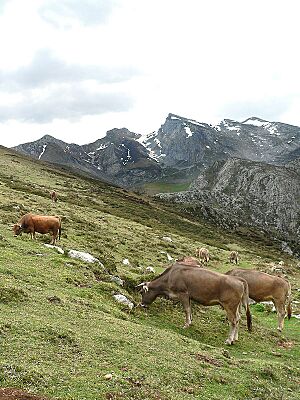
The highest zone in Cantabria is the alpine level. It's only found on the highest mountain peaks of the Picos de Europa and Peña Prieta. In these places, which are above 2,200 meters high, there's a lot of snow, and the steep, rocky land prevents soil from forming well. Because of this, woody plants (trees and large bushes) can't grow. So, the main plant life here is natural grassland. The type of grassland changes a lot depending on the ground. On limestone, which is most common in Cantabria, you'll find dense grasslands with plants like Elyna myosuroides or Salix breviserrata. On more acidic soils that are covered by snow for a long time, found only on the summit of Peña Prieta, the grasslands have species like Festuca eskia or Luzula hispanica.
Finally, on the rocky walls, in cracks and small flat spots where some soil collects, small but very important plants grow. In these areas, endemic species like Aster alpinus, Sempervivum cantabricum, or Armeria cantabrica stand out.
Protected Plant Species
Cantabria has a list of threatened species, which includes plants. This list helps protect plants that are in danger. Even before Spain had a national law for protecting natural areas and wild plants and animals, Cantabria had rules to protect its plants, including algae.
Cantabria was also the first region in Spain to create a law to protect trees. This law lists native forest trees like the common oak, sessile oak, Pyrenean oak, holly, holm oak, Portuguese oak, cork oak, beech, chestnut, ash, maple, linden, elm, birch, alder, yew, Scots pine, poplar, and whitebeam. It also created the idea of a Singular Tree.
In 1986, the yew tree (Taxus baccata) was declared a protected forest species.
The Catalog of Singular Trees of Cantabria lists and protects 214 special trees. These trees are important because of their beauty, size, age, or symbolic meaning. This is the only specific protection for individual plant species in Cantabria.
Also, the Habitat Directive from the European Union includes many plants and animals that are very important to protect. Some of these plants found in Cantabria are:
- Drepanocladus vernicosus
- Sphagnum pylaisii
- Culcita macrocarpa (Woolly tree fern)
- Trichomanes speciosum
- Dryopteris corleyi (Asturian male fern)
- Woodwardia radicans
- Rumex rupestris
- Eryngium viviparum
- Apium repens (Creeping marshwort)
- Soldanella villosa (Snowbell)
- Limonium lanceolatum (Sea lavender)
- Centaurium somedanum (Centaury)
- Omphalodes littoralis
- Veronica micrantha
- Jasione lusitanica
- Santolina semidentata
- Centaurea borjae
- Aster pyrenaeus (Pyrenean aster)
- Luronium natans (Floating water-plantain)
- Narcissus pseudonarcissus nobilis (Wild daffodil)
- Narcissus cyclamineus (Daffodil)
- Narcissus asturiensis (Pygmy daffodil)
- Festuca elegans
- Festuca summilusitanica
See also
 In Spanish: Flora de Cantabria para niños
In Spanish: Flora de Cantabria para niños
- Forests of the Iberian Peninsula
- List of mammals of Cantabria
- Cantabria
- List of Amphibian and Reptile of Cantabria



